翻译理论与实践复习
《翻译理论与实践I》考试理论部分复习提纲

《翻译理论与实践》考试理论部分复习提纲一、翻译定义:1. 张培基——翻译是用一种语言把另一种语言所表达的思维内容准确而完整地重新表达出来的语言活动。
3. 刘宓庆——翻译的实质是语际的意义转换。
4. 王克非——翻译是将一种语言文字所蕴含的意思用另一种语言文字表达出来的文化活动。
5. 泰特勒——好的翻译应该是把原作的长处完全地移注到另一种语言,以使译入语所属国家的本地人能明白地领悟、强烈地感受,如同使用原作语言的人所领悟、所感受的一样。
6. 费道罗夫——翻译就是用一种语言把另一种语言在内容与形式不可分割的统一中所业已表达出来的东西准确而完全地表达出来。
7. 卡特福德——翻译的定义也可以这样说:把一种语言(Source Language)中的篇章材料用另一种语言(Target Language)中的篇章材料来加以代替。
8. 奈达——翻译就是在译入语中再现与原语信息最切近的自然对等物,首先就意义而言,其次就是文体而言。
9. 巴尔胡达罗夫——翻译是把一种语言的语言产物在保持内容方面(也就是意义)不变的情况下改变为另一种语言的语言产物的过程。
纽马克——通常(虽然不能说总是如此),翻译就是把一个文本的意义按作者所想的方式移译入另一种文字(语言)。
10. “Translation is the expression in one language (or target language译入语) of what has been expressed in another language (source language 原语), preserving semantic and stylistic equivalences.” --- Dubois11. “Translating consists in reproducing in the receptor language the closest natural equivalent of the source language message, first in terms of meaning and secondly in terms of style.” ---Eugene Nida12. “Translation is a craft consisting in the attempt to replace a written message and/or statement in one language by the same message and/or statement in another language.” --- Peter Newmark13.Translation or translating is a communicative activity or dynamic process in which the translator makes great effort to thoroughly comprehend a written message or text in the source language and works very hard to achieve an adequate or an almost identical reproduction in the target language version of the written source language message or text.二、翻译标准1. 翻译的标准概括为言简意赅的四个字:“忠实(faithfulness)、通顺(smoothness)”。
翻译理论与实践智慧树答案
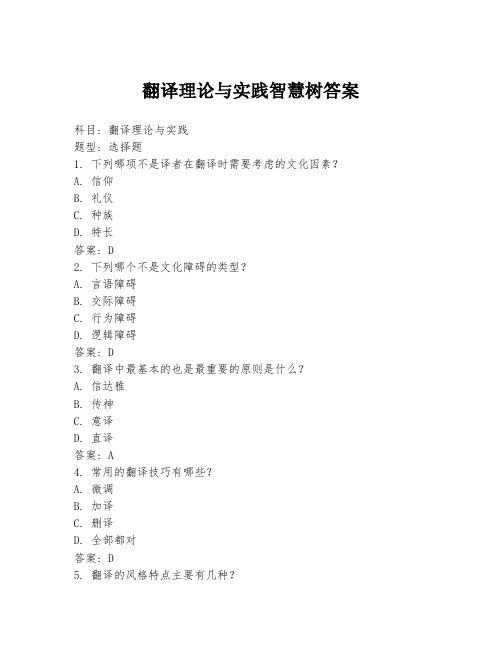
翻译理论与实践智慧树答案科目: 翻译理论与实践题型: 选择题1. 下列哪项不是译者在翻译时需要考虑的文化因素?A. 信仰B. 礼仪C. 种族D. 特长答案: D2. 下列哪个不是文化障碍的类型?A. 言语障碍B. 交际障碍C. 行为障碍D. 逻辑障碍答案: D3. 翻译中最基本的也是最重要的原则是什么?A. 信达雅B. 传神C. 意译D. 直译答案: A4. 常用的翻译技巧有哪些?A. 微调B. 加译C. 删译D. 全部都对答案: D5. 翻译的风格特点主要有几种?A. 浅显易懂型B. 优美文章型C. 客观精确型D. 全部都对答案: D题型: 填空题1. __________ 翻译是指在目标语种中加入某些适当的元素以进行更全面、更精确的信息传达。
答案: 加译2. 在进行情景翻译时,需要将原文中的语境、背景、文化因素等因素与译文的语境、背景、文化因素等进行 __________。
答案: 对等化3. 翻译的信息点是指 __________ 中传达的关键性信息。
答案: 原文4. 交替翻译是指将 __________ 切分成若干小部分,分别进行翻译且所有小部分的翻译结果相连接的翻译方式。
答案: 大段文字5. 翻译中的流畅度主要包括句子的 __________ 和句子之间的衔接。
答案: 语法结构题型: 判断题1. 语言障碍是指由于不同文化语境背景而导致的沟通障碍。
答案: 错误2. 对外汉语翻译中,直译和意译之间没有定性上的区别。
答案: 错误3. 翻译是一项高度受限制的专业,翻译员需对译文的语言、风格、结构、信息点等进行全面的分析和思考。
答案: 正确4. 翻译的最基本原则是信达雅,即要忠实地传达原文的意思,同时保持译文的风格、语言的流畅性。
答案: 正确5. 联想翻译是指根据原文中的某个词或短语的联想意义来对其进行翻译。
答案: 正确题型: 简答题1. 解释直译和意译的区别。
答案: 直译是指把以一种语言写出的原文一字不漏地翻译成目标语言,尽可能贴近译文语言的结构和表达方式。
山西省考研翻译硕士复习资料翻译理论与实践方法重点梳理

山西省考研翻译硕士复习资料翻译理论与实践方法重点梳理翻译理论是翻译研究的基石,对于翻译硕士考试来说,掌握翻译理论是非常重要的。
在准备山西省考研翻译硕士复习资料时,我们应该针对翻译理论的重点进行梳理,并提出相应的实践方法,以提高翻译水平和考试成绩。
一、翻译理论的重点梳理1. 直译与意译直译是指将原文的句子、词语直接翻译成目标语言的句子、词语,保持原文的结构和表达方式。
意译是指在保留原文意思的前提下,采用目标语言的表达方式进行翻译。
在翻译理论中,直译与意译是两种基本的翻译方式,翻译硕士考试会涉及到这两种方式的应用与对比。
2. 文化因素的考虑翻译不仅仅是语言转换,还涉及到文化的传递。
在翻译过程中,要考虑原文中的文化元素,如习惯用语、典故、谚语等,以及目标语言的文化背景,确保译文与目标文化相符合。
此外,对于包含文化内涵的诗歌、歌词等文学作品的翻译,要注重传递原作的意境和情感。
3. 语境的重要性在翻译理论中,语境是不可忽视的因素。
语境包括句子的前后文,以及背景知识等。
在翻译过程中,要全面理解原文所处的语境,尽量还原原文的意思,并在目标语言中找到恰当的表达方式。
同时,有时候还需要根据目标语言的语境进行适当的删减或增加,使译文更符合读者的理解需求。
4. 翻译常用技巧在翻译中,有一些常用的技巧可以帮助我们更好地处理难题。
比如,借用、调整语序、表达方式的转换等。
借用是指使用目标语言中与原文类似的表达方式,以达到更精准的翻译效果。
调整语序则是针对原文句子的结构进行适当的调整,以使译文更符合目标语言的习惯和语法规则。
二、实践方法1. 多读多译多练习为了提高翻译能力,我们需要进行大量的阅读、翻译和练习。
通过读各类不同领域的原文,积累词汇和专业术语,了解不同场景下的语言表达方式。
在翻译过程中,可以选择一些难度适中的文章进行译练,提高语言转换和表达能力。
2. 培养学术素养翻译硕士考试注重考察学术素养,因此我们要注重培养学术素养。
翻译理论与实践试题及答案
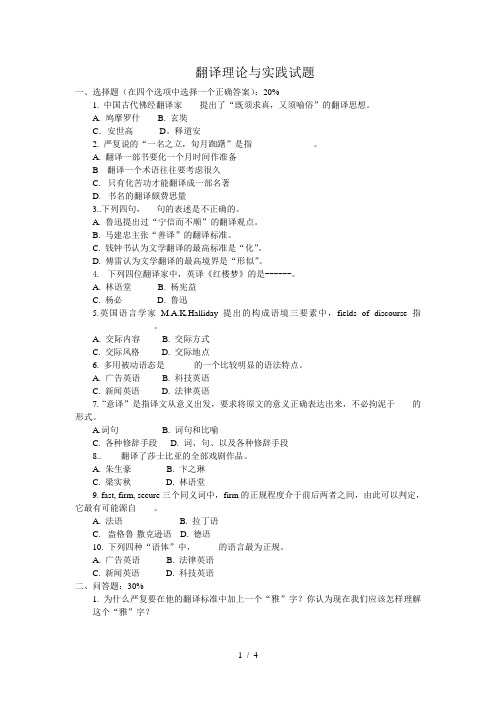
翻译理论与实践试题一、选择题(在四个选项中选择一个正确答案):20%1. 中国古代佛经翻译家------提出了“既须求真,又须喻俗”的翻译思想。
A. 鸠摩罗什B. 玄奘C.安世高D。
释道安2. 严复说的“一名之立,旬月踟躇”是指---------------------。
A. 翻译一部书要化一个月时间作准备B 翻译一个术语往往要考虑很久C.只有化苦功才能翻译成一部名著D.书名的翻译颇费思量3..下列四句,----句的表述是不正确的。
A. 鲁迅提出过“宁信而不顺”的翻译观点。
B. 马建忠主张“善译”的翻译标准。
C. 钱钟书认为文学翻译的最高标准是“化”。
D. 傅雷认为文学翻译的最高境界是“形似”。
4.下列四位翻译家中,英译《红楼梦》的是------。
A. 林语堂B. 杨宪益C. 杨必D. 鲁迅5.英国语言学家M.A.K.Halliday提出的构成语境三要素中,fields of discourse指---------------------------。
A. 交际内容B. 交际方式C. 交际风格D. 交际地点6. 多用被动语态是----------的一个比较明显的语法特点。
A. 广告英语B. 科技英语C. 新闻英语D. 法律英语7. “意译”是指译文从意义出发,要求将原文的意义正确表达出来,不必拘泥于------的形式。
A.词句B. 词句和比喻C. 各种修辞手段D. 词、句、以及各种修辞手段8.. ------翻译了莎士比亚的全部戏剧作品。
A. 朱生豪B. 卞之琳C. 梁实秋D. 林语堂9. fast, firm, secure三个同义词中,firm的正规程度介于前后两者之间,由此可以判定,它最有可能源自------。
A. 法语B. 拉丁语C.盎格鲁-撒克逊语D. 德语10. 下列四种“语体”中,--------的语言最为正规。
A. 广告英语B. 法律英语C. 新闻英语D. 科技英语二、问答题:30%1. 为什么严复要在他的翻译标准中加上一个“雅”字?你认为现在我们应该怎样理解这个“雅”字?2、.我们可以通过观察哪几种“语域标志”来区别英语语言的正规程度?请举例说明其中两种。
翻译理论与实践基础知识回顾课件

翻译理论的主要流派
总结词
翻译理论的主要流派包括语言学派、文学学派、文化 学派和社会学派。
详细描述
语言学派强调语言结构和功能的分析,关注语言之间 的对等和转换。文学学派关注文学作品的翻译,强调 译文的文学性和艺术性。文化学派则关注文化背景和 内涵的传递,强调文化之间的交流和理解。社会学派 则将翻译置于社会语境中考虑,关注翻译的社会功能 和影响。这些流派各有侧重,但都是为了提高翻译的 质量和效果,帮助读者更好地理解和欣赏原作。
01
02
03
增词
在译文中增加一些原文中 没有的词句,以使译文更 加流畅、自然,补充原文 中隐含的译文更加简洁、 明了,避免冗余和重复。
词类转译
改变原文中某些词的词性 ,以适应目标语的表达习 惯和语法规则,使译文更 加地道、自然。
03
语言与文化差异
语言结构差异
翻译理论与实践基础 知识回顾课件
目录
CONTENTS
• 翻译理论概述 • 翻译技巧与实践 • 语言与文化差异 • 翻译中的常见问题与对策 • 翻译工具与技术 • 翻译实践案例分析
01
翻译理论概述
翻译的定义与性质
总结词:翻译是一种跨语言、跨文化的交际活动,是 将一种语言的信息用另一种语言表达出来,以实现信 息的传递和交流。翻译的性质包括语言性、文化性和 交际性。
总结词
文化意象是指在不同文化背景下形成的特定形象或概念,对于翻译者来说,如何 处理这些文化意象是翻译过程中的一大挑战。
详细描述
在翻译过程中,对于一些具有特定文化背景的词汇或表达方式,需要进行适当的 解释或转换,以避免因文化差异造成的误解。例如,“龙”在中西方文化中的含 义截然不同,翻译时需要特别注意。
翻译理论复习总结
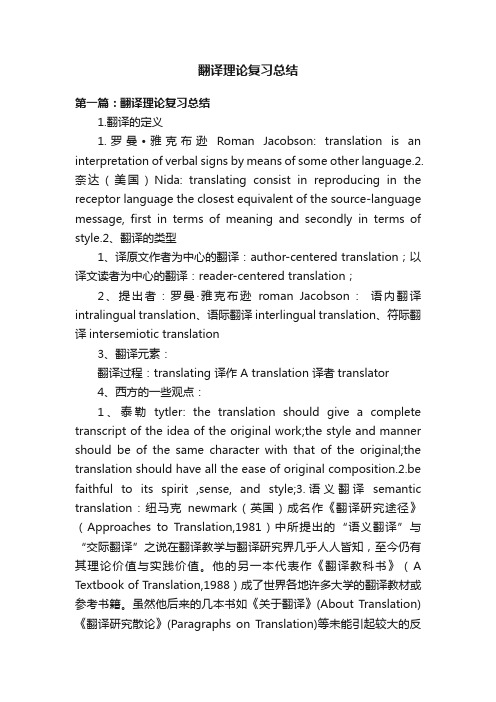
翻译理论复习总结第一篇:翻译理论复习总结1.翻译的定义1.罗曼•雅克布逊Roman Jacobson: translation is an interpretation of verbal signs by means of some other language.2.奈达(美国)Nida: translating consist in reproducing in the receptor language the closest equivalent of the source-language message, first in terms of meaning and secondly in terms of style.2、翻译的类型1、译原文作者为中心的翻译:author-centered translation;以译文读者为中心的翻译:reader-centered translation;2、提出者:罗曼·雅克布逊roman Jacobson:语内翻译intralingual translation、语际翻译interlingual translation、符际翻译intersemiotic translation3、翻译元素:翻译过程:translating 译作 A translation 译者translator4、西方的一些观点:1、泰勒tytler: the translation should give a complete transcript of the idea of the original work;the style and manner should be of the same character with that of the original;the translation should have all the ease of original composition.2.be faithful to its spirit ,sense, and style;3.语义翻译semantic translation:纽马克newmark(英国)成名作《翻译研究途径》(Approaches to Translation,1981)中所提出的“语义翻译”与“交际翻译”之说在翻译教学与翻译研究界几乎人人皆知,至今仍有其理论价值与实践价值。
《翻译理论与实践(笔译)》期末复习辅导 - 萧山电大

浙江广播电视大学英语专业(开放专科)《英语翻译基础》期末复习一、考试题型和模拟题1. 选择题:10题,每题2分,共20分。
范围主要包括翻译标准,直译与意译问题,翻译的定义,文化与翻译的问题。
2. 问答题:1题,共10分。
范围主要包括直译与意译问题,翻译的标准,以及翻译与文化的关系等等。
3.改译句子:10题,共30分。
3. 段落翻译(英译汉):2段,共40分。
一、选择题(在四个选项中选择一个正确答案):1. 明朝末年的翻译家徐光启主要从事--- ---的翻译。
A. 佛教经典B. 文学作品C. 科技著作D. 哲学著作2. 《马氏文通》的作者马建忠提出了“--- ---”的翻译观点。
A. 善译B. 化境C. 神似D. 信、达、雅3. 出版后即风靡海内的《巴黎茶花女遗事》是-- ----的译作。
A.严复 B. 林纾C. 林语堂D. 梁实秋4.“意译”是指译文从意义出发,要求将原文的意义正确表达出来,不必拘泥于-- ----的形式。
A. 词句B. 词句和比喻C. 各种修辞手段D. 词、句、以及各种修辞手段5. 翻译是一种()的交际活动。
A.跨语言,跨文化,跨社会 B. 跨语言C.跨语言,跨社会 D. 跨语言,跨社会6. 翻译的理想单位是:__________。
()A.篇章 B. 句子 C.词语 D. 单词7.下列四个语言特点中,---- --不是广告英语的特点。
A. 多祈使句B. 多后置定语C. 多新词汇D. 多常用词汇8. 鲁迅曾提出过“------- --------”的翻译观点。
A. 宁顺而不信B. 宁信而不顺C. 与其信而不顺,不如顺而不信D. 忠实、通顺、得体9.“Do you see any green in my eye?”可以翻译为:__ _____。
A. 你从我的眼睛里看到绿颜色吗?B. 你以为我是好欺骗的吗?C. 你从我的眼睛里看到嫉妒的感觉吗?D. 你以为我在嫉妒你吗?10. “Last night I heard him driving his pigs to market.” 意思为( )。
翻译理论与实践期末复习
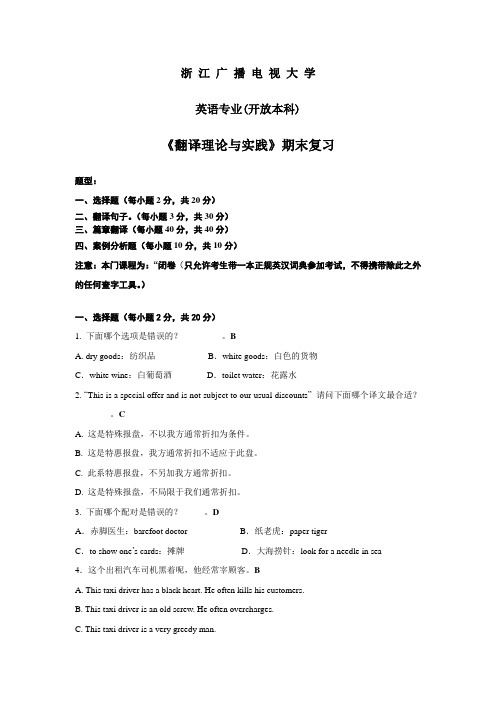
浙江广播电视大学英语专业(开放本科)《翻译理论与实践》期末复习题型:一、选择题(每小题2分,共20分)二、翻译句子。
(每小题3分,共30分)三、篇章翻译(每小题40分,共40分)四、案例分析题(每小题10分,共10分)注意:本门课程为:“闭卷(只允许考生带一本正规英汉词典参加考试,不得携带除此之外的任何查字工具。
)一、选择题(每小题2分,共20分)1. 下面哪个选项是错误的?_________。
BA. dry goods:纺织品B.white goods:白色的货物C.white wine:白葡萄酒D.toilet water:花露水2. “This is a special offer and is not subject to our usual discounts” 请问下面哪个译文最合适?________。
CA. 这是特殊报盘,不以我方通常折扣为条件。
B. 这是特惠报盘,我方通常折扣不适应于此盘。
C. 此系特惠报盘,不另加我方通常折扣。
D. 这是特殊报盘,不局限于我们通常折扣。
3. 下面哪个配对是错误的?_____。
DA.赤脚医生:barefoot doctor B.纸老虎:paper tigerC.to show one’s cards:摊牌D.大海捞针:look for a needle in sea4.这个出租汽车司机黑着呢,他经常宰顾客。
BA. This taxi driver has a black heart. He often kills his customers.B. This taxi driver is an old screw. He often overcharges.C. This taxi driver is a very greedy man.D. This taxi driver is too black to kill the customers.5. 手头上的钱不够用了,他只好打消买皮鞋的念头。
《翻译理论与实践(笔译)》期末复习辅导 - 萧山电大讲解

浙江广播电视大学英语专业(开放专科)《英语翻译基础》期末复习一、考试题型和模拟题1. 选择题:10题,每题2分,共20分。
范围主要包括翻译标准,直译与意译问题,翻译的定义,文化与翻译的问题。
2. 问答题:1题,共10分。
范围主要包括直译与意译问题,翻译的标准,以及翻译与文化的关系等等。
3.改译句子:10题,共30分。
3. 段落翻译(英译汉):2段,共40分。
一、选择题(在四个选项中选择一个正确答案):1. 明朝末年的翻译家徐光启主要从事--- ---的翻译。
A. 佛教经典B. 文学作品C. 科技著作D. 哲学著作2. 《马氏文通》的作者马建忠提出了“--- ---”的翻译观点。
A. 善译B. 化境C. 神似D. 信、达、雅3. 出版后即风靡海内的《巴黎茶花女遗事》是-- ----的译作。
A.严复 B. 林纾C. 林语堂D. 梁实秋4.“意译”是指译文从意义出发,要求将原文的意义正确表达出来,不必拘泥于-- ----的形式。
A. 词句B. 词句和比喻C. 各种修辞手段D. 词、句、以及各种修辞手段5. 翻译是一种()的交际活动。
A.跨语言,跨文化,跨社会 B. 跨语言C.跨语言,跨社会 D. 跨语言,跨社会6. 翻译的理想单位是:__________。
()A.篇章 B. 句子 C.词语 D. 单词7.下列四个语言特点中,---- --不是广告英语的特点。
A. 多祈使句B. 多后置定语C. 多新词汇D. 多常用词汇8. 鲁迅曾提出过“------- --------”的翻译观点。
A. 宁顺而不信B. 宁信而不顺C. 与其信而不顺,不如顺而不信D. 忠实、通顺、得体9.“Do you see any green in my eye?”可以翻译为:__ _____。
A. 你从我的眼睛里看到绿颜色吗?B. 你以为我是好欺骗的吗?C. 你从我的眼睛里看到嫉妒的感觉吗?D. 你以为我在嫉妒你吗?10. “Last night I heard him driving his pigs to market.” 意思为( )。
翻译理论与实践 (文稿)

翻译理论与实践复习资料应英081班痞子第一章翻译的定义和翻译的原则一、翻译的定义1.Translation is the art of recomposing a work in another language without losing its original flaver.( Columbia Encyclopedia)2. Translating consists in reproducing in the recepter language the closest natural equivalent of the source language message, first in terms of meaning and secondly in terms of style. ( Eugene A. Nida )3.翻译是把一种语言表达的意义用另一种语言传达出来,以达到沟通思想感情、传播文化知识、促进社会文明,特别是推动译语文化兴旺昌盛的目的。
(孙致礼 2003:6 )二、翻译的原则1. Yan Fu (1854-1921)In translation, there are three aspects difficult to bring about: faithfulness, expressiveness and elegance. It is no easy work to realize “faithfulness”! If there is only faithfulness without expressiveness , the translation doesn’t amount to translation. From here we can see expressiveness is of great importance. (译事三难,信,达,雅。
求其信已大难矣!顾信矣不达,虽译犹不译也,则达尚焉)Faithfulness means that the translated text should be faithful to the original text.Expressiveness means that the translated text should be expressive and coherent without anything awkward. Elegance means the translated text should keep the style of the original.① Japanese army killed millions of innocent people during the war。
河南省考研翻译硕士复习资料翻译理论与翻译实践技巧
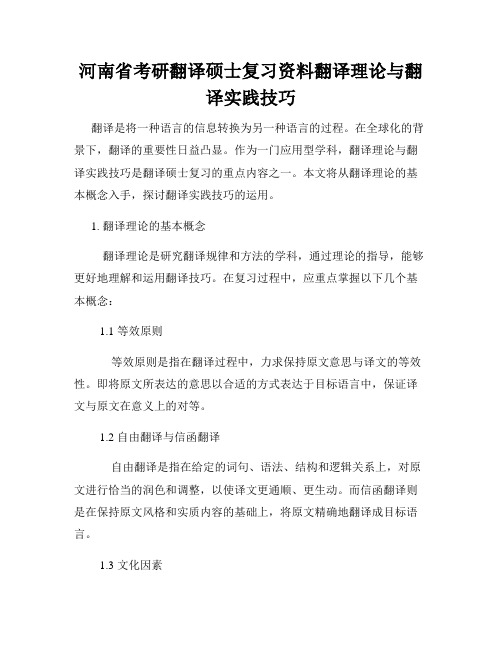
河南省考研翻译硕士复习资料翻译理论与翻译实践技巧翻译是将一种语言的信息转换为另一种语言的过程。
在全球化的背景下,翻译的重要性日益凸显。
作为一门应用型学科,翻译理论与翻译实践技巧是翻译硕士复习的重点内容之一。
本文将从翻译理论的基本概念入手,探讨翻译实践技巧的运用。
1. 翻译理论的基本概念翻译理论是研究翻译规律和方法的学科,通过理论的指导,能够更好地理解和运用翻译技巧。
在复习过程中,应重点掌握以下几个基本概念:1.1 等效原则等效原则是指在翻译过程中,力求保持原文意思与译文的等效性。
即将原文所表达的意思以合适的方式表达于目标语言中,保证译文与原文在意义上的对等。
1.2 自由翻译与信函翻译自由翻译是指在给定的词句、语法、结构和逻辑关系上,对原文进行恰当的润色和调整,以使译文更通顺、更生动。
而信函翻译则是在保持原文风格和实质内容的基础上,将原文精确地翻译成目标语言。
1.3 文化因素翻译不仅仅是两种语言之间的转换,还涉及到两种不同文化之间的交流。
在翻译过程中,必须注意并妥善处理原文中所包含的文化信息,确保翻译结果能够适应目标语言读者的文化背景。
2. 翻译实践技巧的运用翻译实践技巧是在翻译过程中合理运用各种方法和手段,以达到准确传达原文意思的目的。
在复习过程中,需要掌握以下几个实践技巧:2.1 熟悉背景知识要想准确理解原文,必须具备相关领域的背景知识。
在复习时,考生应该扩大自己的知识面,广泛涉猎不同领域的资料,提升自己的综合素质。
2.2 注重语境分析语境是词语意义的重要依据,合理的语境分析有助于准确理解和恰如其分地翻译原文。
在实践中,考生应始终牢记“译文是为读者服务”的原则,注重译文的流畅性和准确性。
2.3 善用词典和工具在翻译实践中,词典和各种翻译工具是不可或缺的辅助工具。
考生应熟悉词典的使用方法,并掌握一些翻译软件的基本操作,以提高翻译效率和质量。
2.4 注意语法和语言风格翻译既要保持原文的语法结构,又要符合目标语言的语法规则。
华中师大《翻译理论与实践》期末考试备考资料全集题参考答案

华中师范大学网络学院《翻译理论与实践》练习测试题(答案及参考译文)一.在下列句中空白处填上合适的词语。
每空1分。
共10分。
1.翻译是跨(语言)、跨(文化)、跨(社会)的交际活动。
2.篇章的粘连分(语义)粘连和(结构)粘连两大类,粘连的目的是实现篇章的(连贯)。
3.社会符号学的翻译标准是(语意)相符、(功能)相似。
4.格赖斯的(合作)原则和利奇的(礼貌)原则是促使语言交际成功的语用原则。
5.社会符号学翻译法以韩礼德所述的语言的社会符号性为根据,以符号学的意义观为核心。
语言符号具备三种意义,它们是(言内)意义、(指称)意义和(语用)意义。
6.语言对比是研究语言在(使用)中产生的意义。
7.泰特勒在《翻译的原则》一书中提出了著名德三原则:A.译文应完整地再现原文的(思想内容)。
B.译文的(风格)、(笔调)应与原文的性质相同。
C.译文应像原文一样(流畅自然)。
8.汉语语法呈(隐含)性,英语语法呈(外显)性。
9.信、达、雅10.忠实通顺11.理解、表达校核12.译出语(或原文)译入语(或译文)13.口译笔译机器翻译14.意美音美形美15.直译16.合句法17.全译摘译编译18.切近自然信息19.口译笔译机器翻译20.易解丰姿21.归化22.神似23. 钱钟书先生提出:“文学翻译的最高标准是‘(化)’。
把作品从一国文字转变成另一国文字,既不能因语文习惯的差异而露出生硬牵强的痕迹,又能完全保存原有的风味,那就算得入‘(化境)’”。
24.从涉及到的语言符号来看,翻译可分为(语内)翻译、(语际)翻译、和(符际)翻译。
(答题顺序可以颠倒)25.所谓功能指语言所具有的种种社会功能。
英国翻译理论家彼得·纽马克将其分为6种:(信息)功能、(表情)功能、(祈使)功能、美感功能、酬应功能和元语言功能。
26.将He is armed to the teeth译成“他全副武装”,采用的是(意译)的方法;将其译成“他武装到了牙齿”,采用的是(直译)的方法。
《斯多布尼科夫和彼得洛娃《翻译理论》的翻译实践报告》范文

《斯多布尼科夫和彼得洛娃《翻译理论》的翻译实践报告》篇一斯多布尼科夫与彼得洛娃《翻译理论》的翻译实践报告一、引言本报告主要针对斯多布尼科夫与彼得洛娃所著的《翻译理论》一书的翻译实践过程进行详细阐述。
通过对该书的翻译实践进行总结,旨在分享翻译过程中的经验、技巧以及所遇到的挑战,并探讨如何提高翻译的准确性和质量。
二、原书简介《翻译理论》一书由斯多布尼科夫与彼得洛娃合著,主要探讨了翻译的基本原理、方法及实践。
本书内容丰富,涵盖了翻译理论、语言对比、文化差异等多个方面,对于翻译从业者及研究者具有较高的参考价值。
三、翻译任务背景本次翻译实践的任务是将《翻译理论》一书从俄语翻译成中文。
鉴于本书在翻译领域的权威地位,我们团队成员在翻译过程中秉持严谨、认真的态度,力求在保证译文准确性的同时,注重语言的流畅性和可读性。
四、翻译过程与方法1. 预译阶段:在正式翻译前,我们团队对原书进行了详细的研读,了解书籍的结构和内容,并制定了详细的翻译计划。
2. 术语准备:针对书中涉及的专业术语和表达方式,我们进行了专门的术语表编制,确保术语的准确性和统一性。
3. 翻译实践:在翻译过程中,我们采用了直译与意译相结合的方法,力求在保持原文意思的同时,使译文更加符合中文表达习惯。
4. 校对与审稿:完成初稿后,我们进行了多次校对和审稿,以确保译文的准确性和流畅性。
五、翻译中的难点与解决策略1. 文化差异的处理:在翻译过程中,我们遇到了许多因文化差异而导致的表达方式不同的问题。
针对这些问题,我们通过查阅相关资料和请教专家,力求找到最合适的表达方式。
2. 专业术语的翻译:本书涉及大量专业术语,我们在术语表的编制和更新上下了很大功夫,以确保术语的准确性和统一性。
3. 长句翻译:原书中有许多长句,我们在翻译时采用了分段、拆句等方法,使译文更加易于理解。
六、翻译质量评估与反思我们认为本次翻译实践的质量主要体现在以下几个方面:1. 准确性:我们在翻译过程中严格遵循原文意思,力求在保持原文意思的同时,使译文更加准确。
上海市考研翻译学复习资料翻译理论与实践核心内容解析

上海市考研翻译学复习资料翻译理论与实践核心内容解析翻译是将一种语言表达转化为另一种语言表达的过程。
而在翻译学中,翻译理论与实践是非常重要的核心内容。
通过对上海市考研翻译学复习资料的翻译理论与实践核心内容的解析,我们可以更好地理解翻译学的基本原理和实践应用。
本文将从翻译的定义、目的、方法以及实践中的问题等方面进行详细分析。
一、翻译的定义与目的翻译是将一种语言的表达形式准确、完整、恰当地转化为另一种语言的表达形式的过程。
翻译的目的是为了在不同语言环境中传递信息、文化和价值。
通过翻译,可以使不同语言之间的沟通和交流更加便捷、准确和广泛。
二、翻译的方法与技巧在翻译的实践中,有很多方法与技巧可以帮助翻译者更好地处理不同语言之间的差异。
首先,翻译者需要具备广泛的文化背景知识,了解源语言和目标语言的文化背景,以便在翻译过程中做出恰当的选择。
其次,翻译者需要注重语言的准确性和自然性,避免产生过度的直译或增删了原文的信息。
最后,翻译者还需要注重上下文的理解,根据上下文选择不同的表达方式,以尽可能准确地传达原文的意思。
三、翻译实践中的问题与挑战在实际的翻译实践中,翻译者常常会面临一些问题与挑战。
首先,语言之间的不对等性会给翻译带来困扰,因为每种语言都有其独特的表达方式和语法结构。
其次,文化差异也是一个重要的问题,因为不同的文化背景可能会对某些词汇或表达方式的理解产生差异。
此外,一些专业领域的翻译也需要翻译者具备相关的专业知识和术语的理解。
综上所述,翻译理论与实践是上海市考研翻译学复习资料中的核心内容。
通过对翻译的定义和目的的理解,我们可以更好地把握翻译的本质和意义。
同时,翻译方法与技巧的应用可以使翻译工作更加准确和自然。
然而,在实际的翻译实践中,翻译者仍然会面临各种问题与挑战。
因此,不断学习和提高自身的翻译能力,是每一个翻译学习者和从业者都需要努力追求的目标。
以上就是对上海市考研翻译学复习资料翻译理论与实践核心内容的解析,希望能够帮助大家更好地理解和掌握翻译学的基本理论和实践应用。
翻译理论与实践(赵秀明)期末复习题

一、翻译的基本理论复习题〔一〕列举至少三种翻译标准〔中、西均可〕,并指出是由谁提出的。
中国的:严复,信雅达三字标准; 林语堂:忠实,通顺,美的标准傅雷,神似;茅盾:意境论;钱钟书:化境赵秀明:韵味说外国的:泰特勒的三原则〔1.译文应完全复写出原作的思想 2.译文的风格和笔调应与原文的性质相同3.译文应和原作同样流畅〕费道罗夫的等值论:等值即译文和原文等值,表现在读者看了原文和译文之后,其感受的等值性。
奈达的等效理论奈达从社会语言学和语言交际功能观点,提出“最接近的,自然的等效翻译〞概念,认为翻译必须以接受者服务为中心,要根据不同接受者的要求对译文作相应调整。
二〕翻译的主要方法有_直译_和_意译_。
“直译〞就是忠实的再现原作思想内容,并尽量保存原作语言形式的表现方法。
原文如在形、义上与译语全同或是基本相同的可以直译,原语中的比喻或形象能为译语读者所接受的有时也可以采用直译。
“意译〞是忠实传达原作思想内容而放弃原作形式。
多强调译文的效果,不求表层次形式对应,只求语言在深层次中的对应。
不是主观臆断,是以不背离原文为限度,注意翻译时对原文结构的调整,用规X的译语表达。
〔三〕列举你所掌握的翻译技巧。
技巧是翻译的具体策略,在直译和意译两大类翻译方法之下,具体的翻译技巧有分切、转换、转移、还原、阐释、融合、引申、反转、替代、拆离、增补、省略、重复、重组、移植等。
再概括起来,可以归结为增、减、移、换四大策略。
〔四〕列举中、西翻译史上著名翻译家至少十位。
傅雷,季羡林,草婴,鲁迅,杨绛,朱生豪,X谷若,诺思,查普曼,费洛里欧,何兰德,阿瑟伟利,弗兰茨库恩,玄奘、义净、徐寿、李善兰、赵元益、卞之琳、叶水夫、黄龙、茅盾;乔叟、西塞罗、哲罗姆、阿尔弗雷德国王、波伊提乌、诺思〔五〕谈谈翻译的困难〔至少两点〕。
首先理解的困难。
汉语和英语都是很发达的语言,以表达丰富细致著称,要理解的准确必须处处细致。
Eg:in the seventh heaven不可按表面译为“升天〞本意是“非常高兴〞:翻译方法的选择是另一困难。
翻译理论与实践考试题库
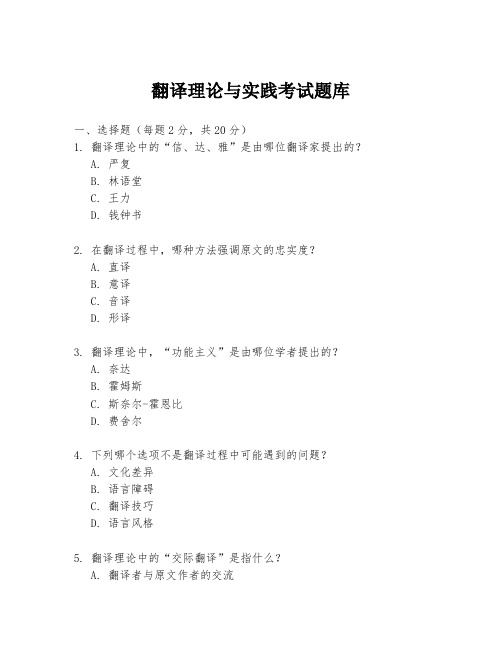
翻译理论与实践考试题库一、选择题(每题2分,共20分)1. 翻译理论中的“信、达、雅”是由哪位翻译家提出的?A. 严复B. 林语堂C. 王力D. 钱钟书2. 在翻译过程中,哪种方法强调原文的忠实度?A. 直译B. 意译C. 音译D. 形译3. 翻译理论中,“功能主义”是由哪位学者提出的?A. 奈达B. 霍姆斯C. 斯奈尔-霍恩比D. 费舍尔4. 下列哪个选项不是翻译过程中可能遇到的问题?A. 文化差异B. 语言障碍C. 翻译技巧D. 语言风格5. 翻译理论中的“交际翻译”是指什么?A. 翻译者与原文作者的交流B. 翻译者与目标语言读者的交流C. 原文与译文的交流D. 原文与目标语言的交流6. 翻译理论中的“动态对等”是由哪位学者提出的?A. 奈达B. 霍姆斯C. 斯奈尔-霍恩比D. 费舍尔7. 在翻译实践中,哪种翻译策略更注重原文的文化内涵?A. 直译B. 意译C. 音译D. 形译8. 翻译理论中的“交际翻译”主要强调的是什么?A. 原文的忠实度B. 译文的流畅性C. 译文的可读性D. 译文的交际功能9. 翻译理论中的“翻译单位”通常指的是什么?A. 词汇B. 句子C. 段落D. 文章10. 在翻译实践中,哪种翻译方法更注重译文的可读性?A. 直译B. 意译C. 音译D. 形译二、简答题(每题10分,共30分)1. 简述翻译理论中的“交际翻译”与“语义翻译”的区别。
2. 描述翻译过程中如何处理文化差异,并举例说明。
3. 阐述翻译理论中的“功能主义”对翻译实践的影响。
三、论述题(每题25分,共50分)1. 论述翻译理论中的“动态对等”理论,并结合实际翻译案例进行分析。
2. 论述翻译实践中如何处理语言风格的差异,并给出具体的翻译策略。
四、翻译实践题(共30分)请将以下中文段落翻译成英文,并注意保持原文的语义、风格和文化内涵。
原文:随着全球化的不断深入,跨文化交流变得越来越重要。
翻译作为跨文化交流的重要工具,不仅要忠实于原文,还要考虑到目标语言的文化背景和读者的接受能力。
《高级英汉翻译理论与实践》复习笔记(翻译单位)【圣才出品】
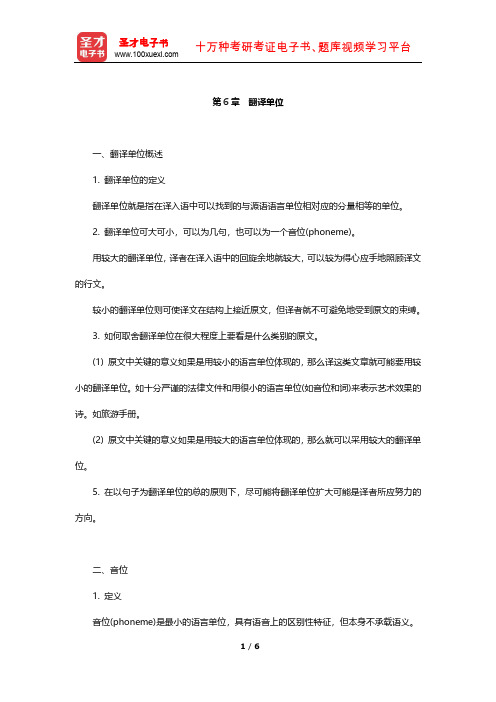
第6章翻译单位一、翻译单位概述1. 翻译单位的定义翻译单位就是指在译入语中可以找到的与源语语言单位相对应的分量相等的单位。
2. 翻译单位可大可小,可以为几句,也可以为一个音位(phoneme)。
用较大的翻译单位,译者在译入语中的回旋余地就较大,可以较为得心应手地照顾译文的行文。
较小的翻译单位则可使译文在结构上接近原文,但译者就不可避免地受到原文的束缚。
3. 如何取舍翻译单位在很大程度上要看是什么类别的原文。
(1) 原文中关键的意义如果是用较小的语言单位体现的,那么译这类文章就可能要用较小的翻译单位。
如十分严谨的法律文件和用很小的语言单位(如音位和词)来表示艺术效果的诗。
如旅游手册。
(2) 原文中关键的意义如果是用较大的语言单位体现的,那么就可以采用较大的翻译单位。
5. 在以句子为翻译单位的总的原则下,尽可能将翻译单位扩大可能是译者所应努力的方向。
二、音位1. 定义音位(phoneme)是最小的语言单位,具有语音上的区别性特征,但本身不承载语义。
音位作为翻译单位在翻译时,如原文中的音位需要在译文中获得对应,音位本身就成了翻译单位。
(1) 适用范围:音译借词(如laser译成“镭射”)和专有名词(如Lincoln译成“林肯”)的翻译。
(2) 音译借词是翻译新词的一种译法。
如nylon(尼龙)和copy(拷贝)。
新词的另一种译法是根据新名词的意思译。
如Laser译为“激光”。
(3) 专有名词的翻译①音译②音意兼顾。
如Yosemite译成“优胜美地”,Coca-Cola译成“可口可乐”。
③专有名词汉译时应切记名从主人这一原则,也就是要尽可能接近原文的发音。
④约定俗成的译名也许并不十分接近原文的音位,但约定俗成也是一个应该记住的原则。
三、词素1. 定义词素(morpheme)是最小的有意义的语言单位,任何一个词素都有意义,而且一个词素只有一个意义。
例:walking有两个词素。
walk是一个词素,其意义是表示一个动词,ing也是一个词素,其意义表示前面那个词素所处的状态正在进行。
《翻译理论与实践(笔译)》复习辅导.
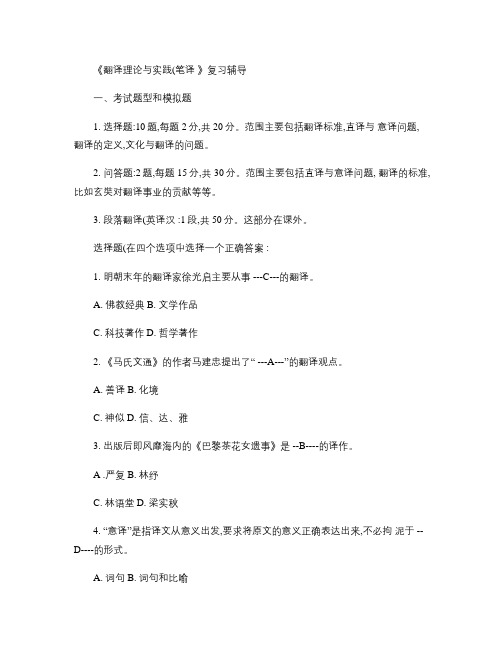
《翻译理论与实践(笔译》复习辅导一、考试题型和模拟题1. 选择题:10题,每题 2分,共 20分。
范围主要包括翻译标准,直译与意译问题,翻译的定义,文化与翻译的问题。
2. 问答题:2题,每题 15分,共 30分。
范围主要包括直译与意译问题, 翻译的标准,比如玄奘对翻译事业的贡献等等。
3. 段落翻译(英译汉 :1段,共 50分。
这部分在课外。
选择题(在四个选项中选择一个正确答案 :1. 明朝末年的翻译家徐光启主要从事 ---C---的翻译。
A. 佛教经典B. 文学作品C. 科技著作D. 哲学著作2. 《马氏文通》的作者马建忠提出了“ ---A---”的翻译观点。
A. 善译B. 化境C. 神似D. 信、达、雅3. 出版后即风靡海内的《巴黎茶花女遗事》是 --B----的译作。
A .严复 B. 林纾C. 林语堂D. 梁实秋4. “意译”是指译文从意义出发,要求将原文的意义正确表达出来,不必拘泥于 --D----的形式。
A. 词句B. 词句和比喻C. 各种修辞手段D. 词、句、以及各种修辞手段5. 翻译是一种(A 的交际活动。
A . 跨语言,跨文化,跨社会 B. 跨语言C . 跨语言,跨社会 D. 跨语言,跨社会6. 翻译的理想单位是:__________。
(A . 篇章 B. 句子 C. 词语 D. 单词7. 下列四个语言特点中, ----B--不是广告英语的特点。
A. 多祈使句B. 多后置定语C. 多新词汇D. 多常用词汇8. 鲁迅曾提出过“ -------B--------”的翻译观点。
A. 宁顺而不信B. 宁信而不顺C. 与其信而不顺,不如顺而不信D. 忠实、通顺、得体9. 在下列四组特点中, ---D---组符合英语语言的实际情况。
A. 重意合,多主动结构,多动态词,多重复,多生物词作主语B. 重形合,多主动结构,多动态词,多替代,多物称词作主语C. 重意合,多被动结构,多静态词,多重复,多生物词作主语D. 重形合,多被动结构,多静态词,多替代,多物称词作主语10. 下列四种语言特点, ----B----不符合英语语言的实际情况。
宁夏回族自治区考研翻译硕士复习资料翻译理论与实践总结
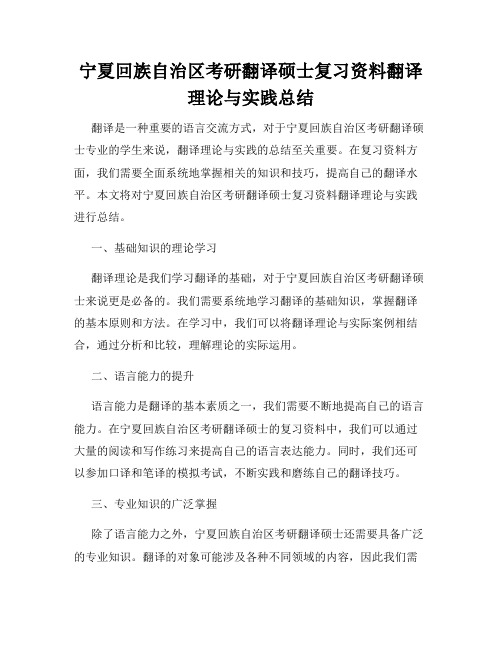
宁夏回族自治区考研翻译硕士复习资料翻译理论与实践总结翻译是一种重要的语言交流方式,对于宁夏回族自治区考研翻译硕士专业的学生来说,翻译理论与实践的总结至关重要。
在复习资料方面,我们需要全面系统地掌握相关的知识和技巧,提高自己的翻译水平。
本文将对宁夏回族自治区考研翻译硕士复习资料翻译理论与实践进行总结。
一、基础知识的理论学习翻译理论是我们学习翻译的基础,对于宁夏回族自治区考研翻译硕士来说更是必备的。
我们需要系统地学习翻译的基础知识,掌握翻译的基本原则和方法。
在学习中,我们可以将翻译理论与实际案例相结合,通过分析和比较,理解理论的实际运用。
二、语言能力的提升语言能力是翻译的基本素质之一,我们需要不断地提高自己的语言能力。
在宁夏回族自治区考研翻译硕士的复习资料中,我们可以通过大量的阅读和写作练习来提高自己的语言表达能力。
同时,我们还可以参加口译和笔译的模拟考试,不断实践和磨练自己的翻译技巧。
三、专业知识的广泛掌握除了语言能力之外,宁夏回族自治区考研翻译硕士还需要具备广泛的专业知识。
翻译的对象可能涉及各种不同领域的内容,因此我们需要对各个领域有一定的了解和掌握。
在复习资料中,我们可以通过学习相关领域的书籍和资料,提升自己的专业素质。
四、实践经验的积累翻译是一项需要实践的工作,理论学习固然重要,但实践经验同样重要。
在宁夏回族自治区考研翻译硕士的复习中,我们可以通过参加实习或实训活动,积累实践经验。
同时,我们还可以尝试翻译一些真实的文章或文本,将学习到的理论知识应用到实际中,不断提高自己的翻译水平。
总结起来,宁夏回族自治区考研翻译硕士复习资料翻译理论与实践是我们备考的重要内容。
在复习过程中,我们需要全面系统地学习翻译理论的基础知识,提升语言表达能力,扩展专业知识面,同时注重实践经验的积累。
通过不断努力,我们相信可以取得优异的考研成绩。
- 1、下载文档前请自行甄别文档内容的完整性,平台不提供额外的编辑、内容补充、找答案等附加服务。
- 2、"仅部分预览"的文档,不可在线预览部分如存在完整性等问题,可反馈申请退款(可完整预览的文档不适用该条件!)。
- 3、如文档侵犯您的权益,请联系客服反馈,我们会尽快为您处理(人工客服工作时间:9:00-18:30)。
翻译理论与实践复习
1.Definitions
*Translation may be defined as the replacement of textual material in one language ( the source language ) by equivalent textual material in another language ( the target language ) (Catford 1965:20)
*Translating consists in reproducing in the receptor language the closest natural equivalent of the source-language message, first in terms of meaning and secondly in terms of style (Nide &Taber 1969:12)
2. Classifications
(a)根据翻译方向来分:source language(译出语)、target/receptor language(译入语)
(b)根据涉及到的语言符号分:Intralingual Translation(语内翻译)、Interlingual Translation(语际翻译)、Interserniotic Translation(符际翻译)
(c)根据翻译的手段来分:Interpretation(口译)、translation(笔译)、computer translation(计算机翻译)
(d)根据翻译的方式分:全译、节译/选译、摘要、改译、编译、综译
(e)从翻译的题材看:专业性翻译、文学翻译和一般性翻译
3. Nature
4.Procedure:理解—表达—校核
5.Criteria (P4-5)
*严复: Triple Principle of Translation (《天演论》1898)
信(faithfulness):忠实准确
达(expressiveness):通顺流畅
雅(elegance):文字古雅
*鲁迅:信(faithfulness)、顺(smoothness)
*思果:信、达、贴
*马建忠:《马氏文通》、善译
*傅雷:神似(resemblance in spirit)
*钱钟书:化境(reaching the acme of perfection)
*刘重德:信、达、切(faithfulness, expressiveness and closeness)
*许渊冲:三重标准(three levels of criteria)(《翻译的艺术》,1984) 意美、音美、形美(信、达、优)
*Alexander Fraser Tytler (泰特勒):Three Principles of Translation) (1) The translation should give a complete transcript of the ideas of the original work(译作应完全传达原作的思想)
(2) The style and manner of writing in the translation should be of the same character with that of the original(译作的风格与笔调应当与原作保持一致)
(3) The translation should have all the ease of the original composition (译作应当和原作一样流畅)
6. Prerequisites of the translator
*Excellent command of the two language
*Considerable knowledge of the two cultures
*Adequate knowledge of the subject matter
*Fair capacity for writing
*Plenty of practice and adequate knowledge of translation theories and skills
*Skills in the use of information technology
7. Three climaxes of translation in China
*1st climax 佛经翻译(西汉—唐宋)
*2nd climax 科技翻译(元明清)
*3rd climax 西学翻译(晚清—五四)
*西汉时期安息人安世高翻译《安般守意经》
*东汉“三支”的翻译(Argument between literal translation and liberal translation appears ):支谶、支亮、支谦
*苻秦时期释道安主持译场,出现有组织的翻译(不通梵文,主张严格直译,译文不增不减,只是在词序上作些调整);提出“五失本,三不易”
*鸠摩罗什:批评前朝翻译文体,检讨翻译方法,改正音译弱点,提倡全面意译,译文有“天然西域之语趣”
*真谛:译经49部
*玄奘:“既须求真,又须喻俗” “五不翻”(即音译)
*古代译经三大家:鸠摩罗什、真谛、玄奘
8. English &Chinese comparisons
*Lexicon: alphabetic vs. ideographic (form vs. content)
*Grammar: overt vs. covert (显性与隐性)
*Syntax: hypotaxis vs. parataxis
*More comparisons: Synthetic vs. Analytic(综合语与分析语)
Complex vs. simplex (繁复与简短)
Rigid vs. supple (刚性与柔性)
Impersonal vs. personal (物称与人称)
Passive vs. active(被动与主动)
Static vs. dynamic (静态与动态)
Abstract vs. concrete (抽象与具体)
Indirect vs. direct (间接与直接)
Substitutive vs. repetitive (替换与重复)
9. Translation methods/ strategies
*Literal translation (cf. word for word translation)
*Liberal translation (cf. free translation)
*Transliteration(音译)
* Foreignizing translation (异化翻译) and domesticating translation(归化翻译)。
